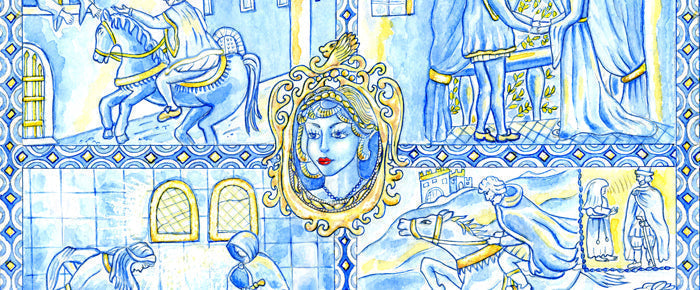From the outside, Laura Lanza was a rich and beautiful Sicilian noblewoman who seemed to have it all. She was the Baroness of Carini, a town nearby Palermo, and lived in the grand castle that still to this day dominates the town and overlooks the sunny Mediterranean Sea.
But it was in this very castle that, on 4th December 1563, Laura was brutally murdered. The killer was the person she would have least expected and that, on the contrary, she welcomed with trust. What paramount offense did Laura commit to deserve such fate?

In order to understand the Baroness' unfathomable death, we have to try and understand the story of her life.
Laura was married at the age of fourteen to Baron Vincenzo La Grua, through an arranged marriage imposed on both spouses. The architect of this union was Laura's father, Cesare Lanza, a powerful Count with growing political aspirations. The lavish wedding ceremonies lasted an entire month and, more than a celebration of love, they were meant to display the power of Count Cesare Lanza.
After giving her husband Vincenzo a first son and heir, Laura finally gained some freedom to discretely love somebody of her choice. This was quite normal among the European nobility of the 16th century. And also Vincenzo was reported to have a rich love life of his own. Although Laura could have taken many lovers, she only loved one man until her death, Ludovico Vernagallo, whom she had loved since a young age.


THE PLOT
Laura and Ludovico's relationship had supposedly been known and tolerated by Vincenzo. All that until somebody informed Laura's father of the ongoing affair.
To proud and stern Don Cesare, the family name Lanza had been dishonored, and honor needed to be restored. The idea that the town knew and might have been "talking" behind his back was, to him, intolerable. He rushed to meet Vincenzo, and made him part of his plan. We don't know how much choice did husband Vincenzo have in this matter because, as we are about to see, different speculations have been made.
What we know is that Cesare organized for him and Vincenzo to surprise the lovers together. All clues point to a premeditated murder, since Cesare carefully planned for his armed guards to surround the castle and prevent anybody from escaping. There is no proof the victims were found in bed together (as Cesare later claimed in his confession), and it's even possible that Ludovico had been summoned to the castle with an excuse. But once in front of the lovers, apparently Vincenzo didn't have the heart to act, so Cesare took it upon himself to kill his daughter and her lover. Laura was only 34 years old.
These verses have became infamous:
"Signuri patri, chi vinistivu a fari?"
"Signura figghia, vi vegnu a ‘mmazzari""Father, what business brings you here?"
"Daughter, I've come to kill you"
INJUSTICE WAS SERVED
Not only was Laura denied the right to live, but also the right to justice. After the event, the law stood on the side of Cesare Lanza, and the King granted pardons to both murderers. Honor killings were in fact legal at that time, if certain peculiar "rules" were followed.
The father had the right to kill his daughter and her lover, but only under three conditions: they had to be caught in the act, either inside the husband's home or the lover's home (no third parties' houses), and none of them had to be spared. If these conditions were met, then it would not be considered a homicide. The father was in fact considered as the owner of his daughter, from which the famous Italian expression padre-padrone originated (literally, father-owner).
Also the husband had the right to kill, but only the lover and not the wife. This right was further restricted if the lover was a nobleman, in which case he should just be held captive until authorities arrived.
A woman, on the contrary, was expected to silently tolerate the adultery of men, making this "double standard" both legal and common practice at that time.

Original death certificate of Laura and Ludovico. There was no attempt to hide the documents, or falsify the names.
No cover-up was necessary because nothing abnormal had happened for the jurisprudence of the day.
QUESTIONABLE MOTIVES
According to the law, if the husband didn't do anything at all about adultery, he could be accused of exploiting prostitution. This is why some believe that Vincenzo didn't have much choice in the matter after father-in-law Cesare Lanza openly confronted him with the news of adultery. But many others who studied the case beg to differ and think that Vincenzo, on the contrary, had plenty of choice (and motives) in "suddenly" discovering the affair.
Rumors from the town suggested that when Laura's first son died at the age of 15, Vincenzo could not risk that his possessions and title go to the second born, whose paternity he doubted. He also feared that Ludovico himself could claim financial rights for fathering children with his wife. This financial explanation is corroborated by the fact that, soon after the pardon, Vincenzo immediately remarried and disinherited all Laura's children.
Interestingly, also the father Cesare might have had important financial reasons. In fact, he owed a hefty sum to wealthy Ludovico, and the killing offered him the chance to wipe off the debt. On top of that, an ancient Roman law ruled that half of the adulterous woman's dowry should be returned to the father, and let's notice that in Laura's case this was a substantial sum.
THE GHOST
Laura did not use her hands to defend herself from the dagger. Incredulous and still respectful of her father's authority, Laura used her hands to simply hold her wound. As her body quickly weakened, she looked for support and placed one hand against the wall, leaving a blood handprint. The wall of her bedroom, once witness of a flourishing romance, was now the only witness of her painful descent.
The inhabitants of Carini and workers of the castle have reported that, on the anniversary of her death, the blood handprint reappears on the very same wall. Some have repeatedly spotted her spirit floating around the castle, overlooking the deep blue sea that she once so much loved.

Particular of the MedievalMade design: the bedchamber where the two lovers once met is now the scene of the murder. Don Cesare flees the castle, but the dropped dagger incriminates him. Forced to take responsibility, he delivers a letter of confession to a nun, where he claims "honor killing". The confessional letter is now housed at the Mother Church in Carini. At the center of the scene, Laura's ghost still roams the castle.
In a strange twist of fate, Laura is still alive. True occurrence or mere figment of imagination, it doesn't matter: her ghost is the embodiment of a popular memory that has lived on. Her story has been passed down from mothers to daughters for generations.
Almost 500 years have passed and Laura's story still resonates with us. Why?
By remembering, the population has restored life where life was denied, and has given a voice to all the women who have been silenced by oppression. The resilience of memory is, by itself, a revolutionary form of justice that women have historically practiced all over the world. Remembering is putting order into chaos, an attempt to give meaning to the senseless.
Every time we share Laura's story, we support the rights of all women to live, to love, and to pursue happiness.

Credits:









